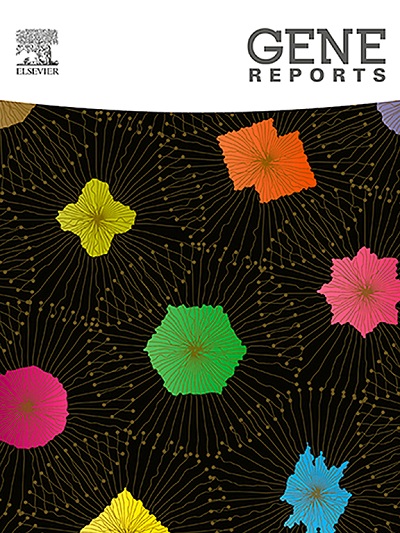Assessment of fish diversity using DNA barcoding from the Beas River in Himachal Pradesh for conservation and sustainable management
IF 0.9
Q4 GENETICS & HEREDITY
引用次数: 0
Abstract
Beas River is one of the major rivers in Himachal Pradesh, frequently impacted by flash floods in the upper reaches, causing biodiversity loss. DNA barcoding using the cytochrome c oxidase I (COI) gene is widely used in assessing biodiversity and species identification. The current study represents the identification of fish fauna using the COI gene sequences in the Beas River basin in Himachal Pradesh. A total of 69 barcodes were generated, and molecular-based identification approaches such as Barcode Index Number, Automatic Barcode Gap Discovery were also employed. Along with molecular identification, biometric characters, including total length and meristic characters, were also measured for the observed species. In the present study, 35 fish species belonging to 27 genera, 10 orders, and 14 families were identified through DNA Barcoding using the 69 partial sequences of the mitochondrial COI gene. Out of 35 fish species, 3 species were Vulnerable, 1 species was Near Threatened, and 1 Endangered species was reported. Barcode sequence similarity of approximately all sequences was found to be 98–100 % identical with NCBI GenBank and BOLD system. The mean K2P genetic divergence from within species, within genera, within families and within orders were 0.50 %, 1.30 %, 5.80 %, and 8.20 %. A Maximum likelihood (ML) tree was also constructed, and all species revealed a distinct separation among the ten orders and fourteen families. The results of current study will aid other researchers in species identification and policymakers in formulating strategies for sustainable biodiversity management and conservation in Himachal Pradesh, Northern India.
利用DNA条形码评估喜马偕尔邦双鱼河鱼类多样性的保护和可持续管理
双鱼河是喜马偕尔邦的主要河流之一,经常受到上游山洪暴发的影响,造成生物多样性的丧失。利用细胞色素c氧化酶I (COI)基因进行DNA条形码已广泛应用于生物多样性评估和物种鉴定。本研究利用COI基因序列对喜马偕尔邦双鱼河流域鱼类区系进行了鉴定。共生成了69个条形码,并采用了基于分子的条形码索引号、自动条形码缺口发现等识别方法。在进行分子鉴定的同时,还测定了所观察物种的生物特征,包括总长度和分分体特征。本研究利用线粒体COI基因的69个部分序列,通过DNA条形码技术鉴定了14科10目27属35种鱼类。35种鱼类中,易危3种,近危1种,濒危1种。几乎所有序列的条形码序列相似性与NCBI GenBank和BOLD系统相似度为98 ~ 100%。种内、属内、科内和目内K2P遗传变异的平均值分别为0.50%、1.30%、5.80%和8.20%。构建了最大似然树(ML),所有种在10目14科中均有明显的分离。目前的研究结果将有助于其他研究人员在印度北部喜马偕尔邦的物种鉴定和决策者制定可持续的生物多样性管理和保护战略。
本文章由计算机程序翻译,如有差异,请以英文原文为准。
求助全文
约1分钟内获得全文
求助全文
来源期刊

Gene Reports
Biochemistry, Genetics and Molecular Biology-Genetics
CiteScore
3.30
自引率
7.70%
发文量
246
审稿时长
49 days
期刊介绍:
Gene Reports publishes papers that focus on the regulation, expression, function and evolution of genes in all biological contexts, including all prokaryotic and eukaryotic organisms, as well as viruses. Gene Reports strives to be a very diverse journal and topics in all fields will be considered for publication. Although not limited to the following, some general topics include: DNA Organization, Replication & Evolution -Focus on genomic DNA (chromosomal organization, comparative genomics, DNA replication, DNA repair, mobile DNA, mitochondrial DNA, chloroplast DNA). Expression & Function - Focus on functional RNAs (microRNAs, tRNAs, rRNAs, mRNA splicing, alternative polyadenylation) Regulation - Focus on processes that mediate gene-read out (epigenetics, chromatin, histone code, transcription, translation, protein degradation). Cell Signaling - Focus on mechanisms that control information flow into the nucleus to control gene expression (kinase and phosphatase pathways controlled by extra-cellular ligands, Wnt, Notch, TGFbeta/BMPs, FGFs, IGFs etc.) Profiling of gene expression and genetic variation - Focus on high throughput approaches (e.g., DeepSeq, ChIP-Seq, Affymetrix microarrays, proteomics) that define gene regulatory circuitry, molecular pathways and protein/protein networks. Genetics - Focus on development in model organisms (e.g., mouse, frog, fruit fly, worm), human genetic variation, population genetics, as well as agricultural and veterinary genetics. Molecular Pathology & Regenerative Medicine - Focus on the deregulation of molecular processes in human diseases and mechanisms supporting regeneration of tissues through pluripotent or multipotent stem cells.
 求助内容:
求助内容: 应助结果提醒方式:
应助结果提醒方式:


